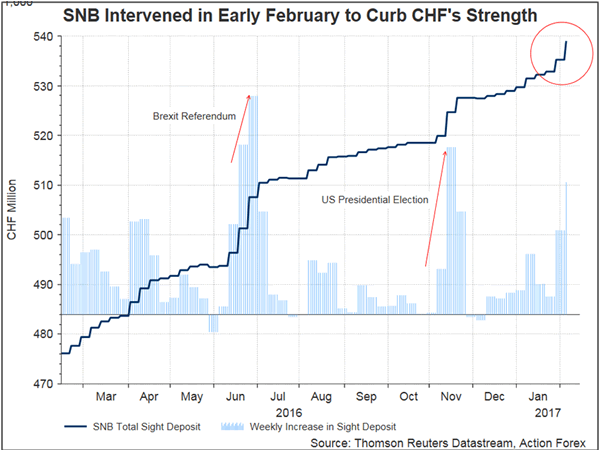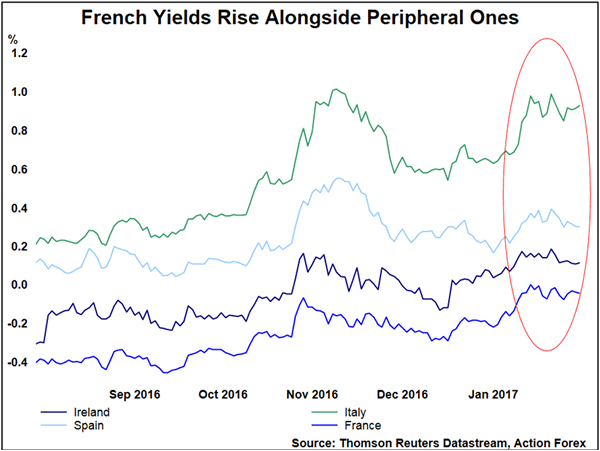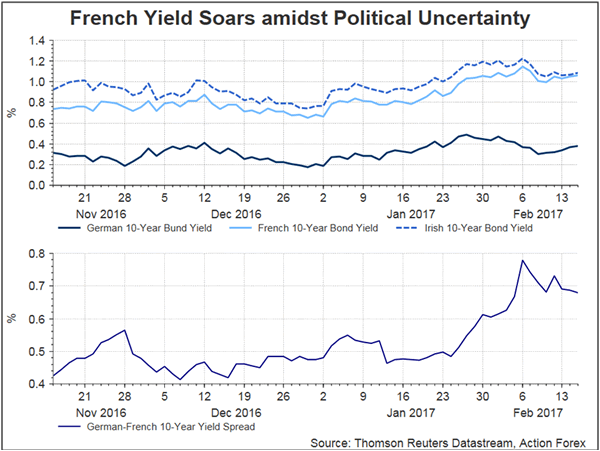SNB’s sight deposits added +3.81B franc, or +0.71%, to 539B franc, in the week ended February 8. This marks the biggest increase since November when the central bank intervened in the aftermath of Donald Trump’s victory. The move this time was, again, to curb the strength of the franc with EURUSD breaking below the support level of 1.0676/84 in late January. There are several reasons that have triggered the recent EURCHF selloff: intensifying political risks associated with upcoming elections in the Eurozone, rising of Swiss bonds yields alongside German ones, and concerns over US’ accusation of currency manipulation. We retain our forecast that EURCHF would weaken further. While SNB’s intervention would continue, the central bank is likely more tolerable over modest franc appreciation given better domestic economic developments

Eurozone Political Risks:
As the market awaits the first round of the French presidential election, scheduled on April 23, rising popularity of the far-right candidate Marine Le Pen, leader of the Front National Party, has raised concerns over Frexit, a French departure from the EU. The market had also begun talking about Nexit (the Netherlands leaving EU) and Grexit (Greece leaving EU) as Dutch election is coming next month while Greece is once again on the verge of financial crisis. Heighted political risks can be exemplified in the widening in European sovereign spreads since end of January. The chart below shows that German-French 10-year yield spread has widened to the highest level since 2013 on February 6. Despite the pullback since then, the spread has remained elevated. Meanwhile, French bond yields have risen to the levels very close to those of Ireland.


Swiss Yields Moving Higher
SNB has been maintaining the sight deposit rate unchanged at -0.75%, and the target for the three-month Libor at between -1.25% and -0.25%, for some time. Yet, we notice that Swiss yields have actually bottomed out in mid-2016. The chart below shows that Swiss 10-year bond yield have been tracking its German counterpart. The positive correction has increased since Trump’s victory in November. Rising Swiss bond yields might be a reason why franc’s upside is not much dampened by SNB’s negative rate policy.

Currency Manipulator?
US President Donald Trump’s preference for a weak USD has raised expectations that his administration would strengthen accusations over currency manipulation: the tactic of weakening a country’s currency so as to increase competitiveness of the country at the expense of others. According to the US Treasury Department, the three criteria for a country to be considered a currency manipulator include 1) an economy has a trade surplus with the US above US$20B, 2) an economy has a current account surplus amounting to more than 3% of its GDP and 3) an economy that repeatedly depreciates its currency by buying foreign assets equivalent to 2%. Switzerland has been in US’ watch list for some time. Although the country runs trade surplus of less than US$20B with the US, the trend is on the rise. Meanwhile, Switzerland has a current account surplus of around 10% of GDP and it spends as much as 9% of its annual GDP on currency intervention. Speculations that the US would eventually criticize Switzerland on the issue have driven the franc higher.


Event Calendar
Mar 15 Wed Dutch election
Mar 17-18 G20 Finance Ministers meeting
Mar 26 Sun Germany Saarland state elections
Mar 31 Current deadline to trigger Article 50
Apr 23 French presidential election (first round)
Apr 28 German FDP Federal party conference
May 07 French presidential election (second round)
May 07 German Schleswig-Holstein state elections
May 11-13 Finance Ministers meeting
May 12 German North Rhine-Westphalia state elections
May 26-27 G7 Summit Sicily
Jul 07-08 G20 summit Hamburg
Sep 24 German Federal Election













